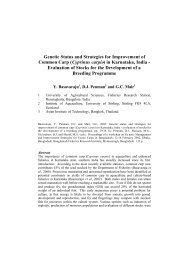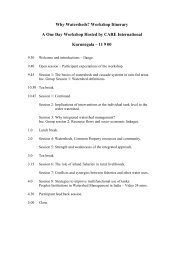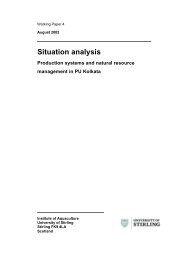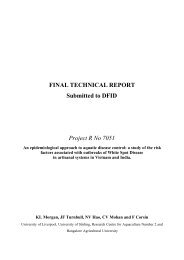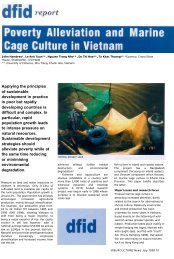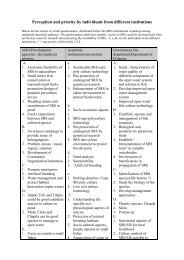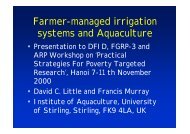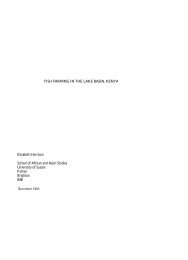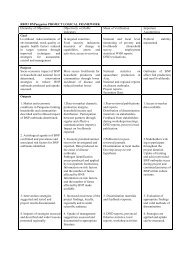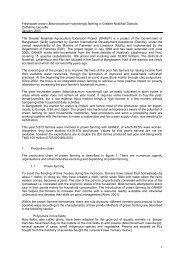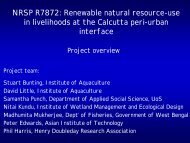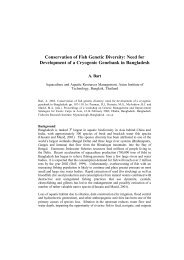Epizootic Ulcerative Syndrome (EUS) Technical Handbook
Epizootic Ulcerative Syndrome (EUS) Technical Handbook
Epizootic Ulcerative Syndrome (EUS) Technical Handbook
You also want an ePaper? Increase the reach of your titles
YUMPU automatically turns print PDFs into web optimized ePapers that Google loves.
HistoryFor over 25 years, outbreaks of an ulcerative disease, characterised histologicallyby mycotic granulomas, have affected freshwater and estuarine fishes overmuch of Asia and Australia. The disease has been given various names, butis most commonly known as mycotic granulomatosis (MG) in Japan, red spotdisease (RSD) in Australia, and epizootic ulcerative syndrome (<strong>EUS</strong>) inSoutheast and South Asia. MG, RSD and <strong>EUS</strong> have, in the past, been describedseparately as distinct conditions, however recent studies have shown that thesame pathogenic Aphanomyces fungus is involved in each case (see Aetiologysection on “Fungi”) and it is now apparent that an account of the history of <strong>EUS</strong>would be incomplete without consideration of outbreaks in Japan andAustralia.Mycotic granulomatosis (MG)The first report of an <strong>EUS</strong>-like condition came in summer 1971, in farmed ayu(Plecoglossus altivelis) in Oita Prefecture, Japan (Egusa and Masuda, 1971).The characteristic lesion, a granulomatous response to invasive hyphae, wasdescribed and the disease was named mycotic granulomatosis (Miyazaki andEgusa, 1972). It rapidly spread to several other Prefectures and affectedvarious species of fish, predominantly cultured ayu and goldfish (Carassiuscarassius auratus); and wild Formosan snakehead (Channa maculata), cruciancarp (Carassius auratus), bluegill (Lepomis macrochirus) and grey mullet (Mugilcephalus) (Miyazaki and Egusa, 1972; 1973a; b; c). Significantly, common carp(Cyprinus carpio) were not affected. Hatai et al. (1977) isolated the invasiveOomycete fungus from affected fish and subsequently called it Aphanomycespiscicida (Hatai, 1980). A. piscicida is now known to be con-specific with the<strong>EUS</strong> pathogen, Aphanomyces invadans (Lilley et al., 1997a; b). Althoughserious MG epizootics have not been reported in Japan since 1973, outbreakshave continued to occur periodically. Recently Hatai et al. (1994) reported asimilar disease in imports of ornamental dwarf gourami (Colisa lalia) fromSingapore, again shown to involve the same Aphanomyces pathogen (Lilley etal., 1997a).Red spot disease (RSD)In 1972, outbreaks of a cutaneous ulcerative condition called red spot disease(RSD) affected estuarine fish, particularly grey mullet (Mugil cephalus), inQueensland, Australia (McKenzie and Hall, 1976). The disease later progressedto affect freshwater and estuarine fish in coastal rivers in New South Wales(Callinan et al., 1989), Northern Territory (Pearce, 1990) and Western Australia(Callinan, 1994a).An Aphanomyces fungus was recovered from diseased fish by Fraser et al.(1992) and was shown to reproduce the disease in fish using bath challenges,but only when the skin of experimental fish was artificially abraded (Callinan,3




